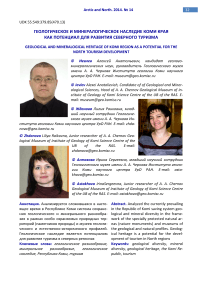Geological and mineralogical heritage of Komi region as a potential for the development of the North tourism
Автор: Ievlev A.A., Jdanova L.R., Astahova I.S.
Журнал: Arctic and North @arctic-and-north
Рубрика: Regionology of the Arctic and North: Management, Economy, Sozium, Culture
Статья в выпуске: 14, 2014 года.
Бесплатный доступ
Analyzed the currently prevailing in the Republic of Komi saving system geological and mineral diversity in the framework of the specially protected natural areas (nature monuments) and museums of the geological and natural profiles. Geological heritage is a potential for the development of tourism in North regions.
Geological diversity, mineral diversity, geological heritage, the Komi Republic, tourism
Короткий адрес: https://sciup.org/148319865
IDR: 148319865 | УДК: 55:549:379.85(470.13)
Текст научной статьи Geological and mineralogical heritage of Komi region as a potential for the development of the North tourism
The geological diversity (geo raznoobrazie) of any object (field, a particular region of the country, the Earth as a whole) means the totality of all of its existing forms of minerals described on several levels: individuals and mineral aggregates, mineral species, mineral associations, min--‐ eral body and some geological features. Geo diversity destroyed as a result of natural processes, and as a result of large--‐scale mining, engineering and agricultural activities of human civilization. Significant part of the geo diversity destroyed as a result of mining activities, sometimes without even being noticed, identified and adequately studied.
Geo diversity has the crucial understanding for the sustainable development of the bio--‐ sphere as a medium of the existence of the various forms of life. On the other hand, minerals, ores and rocks --‐ the foundation of our technological civilization. However, unlike the living matter, ores and minerals can not be played, and their destruction (use) is irrevocable. Very few natural pro--‐ cesses helps to create and even multiply mineral diversity (eg, weathering of rocks).
Saving geological diversity – is as the fundamental problem facing of human civilization, as well as the preservation of the biological diversity. Geological diversity is currently regarded by many experts as an organic part of the world human heritage in need of the special protection and conservation.
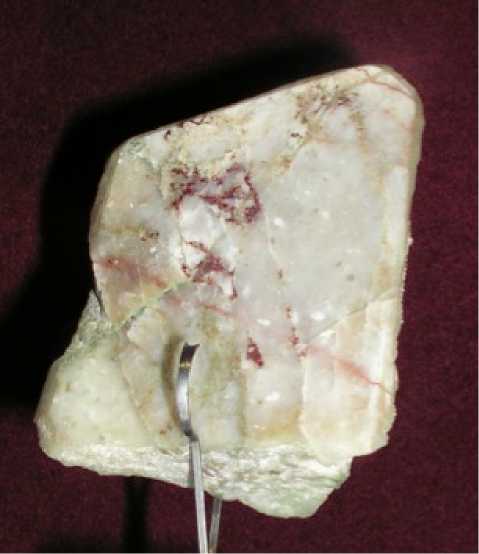
Pic. 1. Rhyolitic quartz porphyry with pemontitom and chernovitom (from the collection of the Geological Museum named after A. A. Chernov)
Saving of geo diversity is a kind of "compensation" from the destructive nature (human community, the subsoil user, builder, etc.), which is aimed at meeting the needs and requirements
(cultural, scientific, historical, educational, aesthetic, etc.) today and future generations. This com--‐ pensation is a special way of the continued life of that nature, which will be destroyed forever.
Geological and mineral diversity of Timano--‐ North Ural region
Timan--‐Northern Region is defined as a vast territory covering the Republic of Komi, Nenets Autonomous District and bordering areas with them. Geologically, this region is represented: the northern part of the Ural fold system and the Ural foredeep, Pechora basin, and the Timan ridge, Mezenskaya syneclise and the north--‐western part of the Volga--‐Ural anticline. Such a wide variety of the geological formations in the region predetermined its geological and mineral diversity.
The list of minerals Timan--‐Northern Region currently includes 619 mineral species and 129 varieties. The region was the world's first unique minerals found Chernoff YAsO4 (named in honor of an outstanding researcher bowels of the European North of Russia Professor A. A. Chernov) [3 (Fig. 1), Yushkina V1--‐xS ·∙ n [(Mg, Al) (OH) 2] (named after academician N. P. Yushkina) [4] (Fig. 2), Tsaregorodtseva N (CH3) 4 [Si2 (Si0.5Al0.5) O6] 2 (named after the Ural mineralogist C. V. Tsare--‐ gorodtseva) (Fig. 3). Most recently, the region's mineral inventory was replenished rare mineral emiliitom Cu2.12Pb1.97Bi3.88S10.35 [1] .
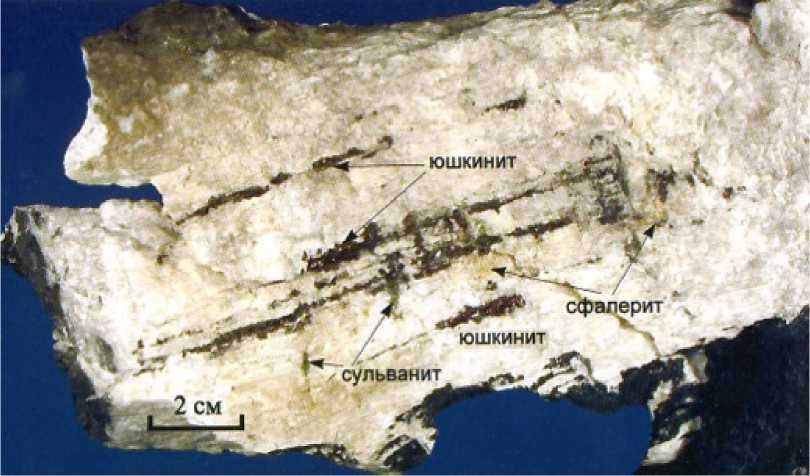
Pic. 2. Quartz--‐calcite vein with yushkinit, sphalerite and sulvanitom [4
The system of the protected natural areas of the Republic Komi
In the Komi Republic, a network of protected areas (PAs), which includes about 250 ob--‐ jects. Two of them --‐ the Pechora--‐Ilych Nature Reserve and National Park "Yugyd va" are included in UNESCO World Heritage List. The list of protected areas of significant scientific and educational interest represent different geological features associated with the ancient history of the Earth or human activities on the development of mineral resources in the region.
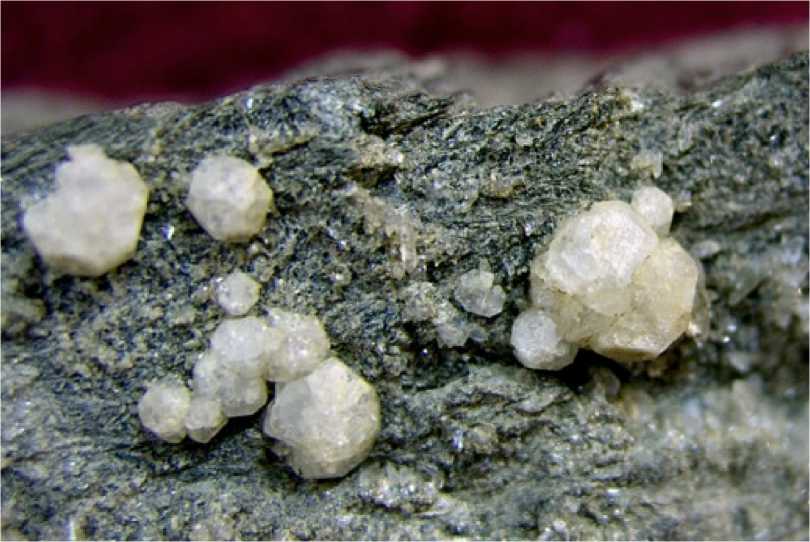
Pic. 3. Tsaregorodtsevit (from the collection of the Geological Museum named after A.A. Chernov)
Starting work on the identification of targeted natural geological attractions in the Kom Republic was initiated in the late 1930s. V.A. Varsanofev (Fig. 4). It was she, who first pointed to the need to preserve many unique objects of global importance, including stone "boobs" on Man--‐ Pupuner plateau.
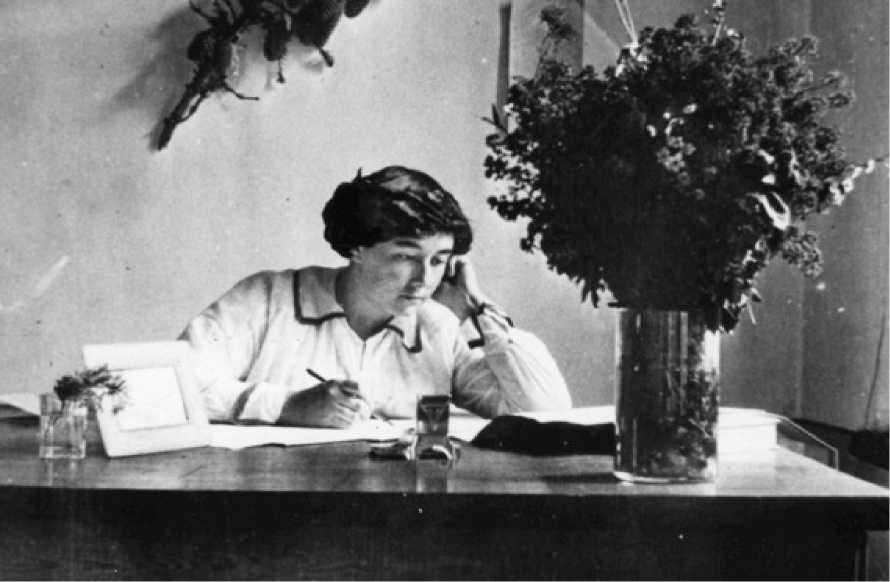
Pic. 4. Vera Aleksandrovna Varsanofieva, 1914. (photo from archieve of geological museum named after A.A. Chernov)
The status of the "state nature monument" in the Komi Republic appeared in 1964, but un--‐ til then unique geological features only recorded in the Komi Branch of the USSR Academy of Sci--‐ ences and the Council of the Komi--‐Union Society for Nature Conservation [2].
The first government document formalized the status of protected areas for the geological objects near the Komi Republic, became the Council of Ministers of the Komi ASSR March 5, 1973 № 91 "On declaring the monuments of nature unique natural formations in the Komi Republic. It was formed 20 geological monuments in Northern and Polar Urals, the list includes karst for--‐ mations and caves ( Log Jordan, Uninskya, Kanin, Bear, tuffs and Ice Caves), outliers or "doodles" on the hillside Man--‐Pupuner (Fig. 5), as well as exposure--‐stratotypes, reference sections and the location of various paleontological fossils.
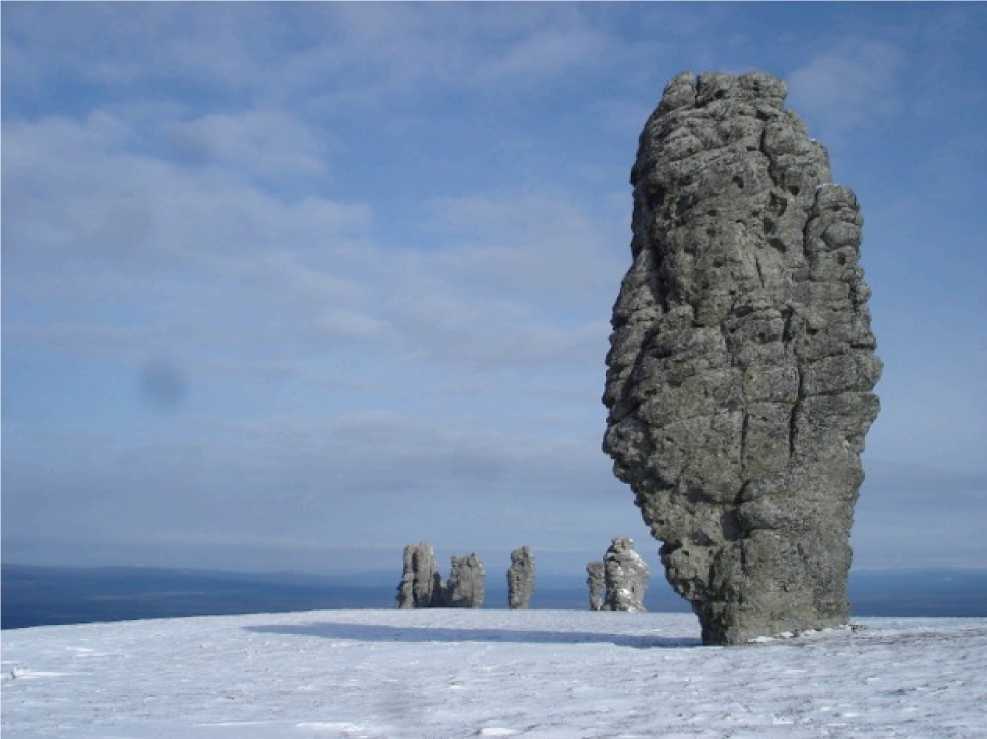
Pic. 5. Stone "doodles" on the plateau Man--‐Pupuner (Northern Urals). Photo V.V. Udoratina, 2012
In March 1984 was formed 21 additional natural monument geological profile, in Septem--‐ ber 1989 --‐ 12 more such sites and one geological reserve. Thus, by the early 1990s, 54 objects re--‐ ceived state protection status.
However, in 2002--‐2004, in the inventory of the protected areas were abolished as inde--‐ pendent 30 geological monument located in the protected areas of the National Park "Yugyd va" and Pechora--‐Ilych Reserve, ie the number of legally registered geo monuments reduced to 24. Correct legally move led to the fact that there were difficulties with the control of the state of the monuments from professionals and was a kind of "dissolution" of the unique geological for--‐ mations with the disappearance of information about them in the official environmental docu--‐ ments [2].
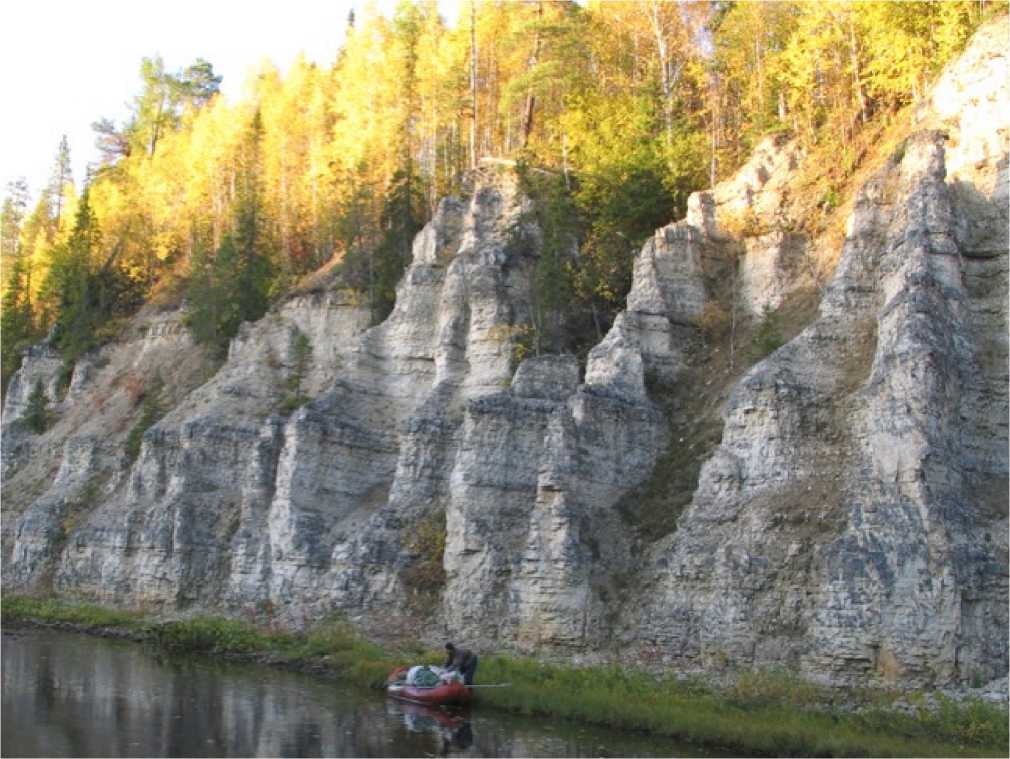
Pic 6. Geological reserve "Rocks of Kamenki", r. Ydzhyd--‐Kamenka (basin. Pechora) [2
Currently, the list of the geological monuments of the Komi Republic, compiled by the sci--‐ entists and experts, includes about 140 miraculous and man--‐made objects. Among them --‐ the caves, scenic landforms (Fig. 6), points the fossil organisms, historic sites of ancient mountain crafts(Fig.7), a natural reference geological sections and much more. However, many objects un--‐ doubtedly interesting scientific, historical, cultural, moral and aesthetic aspect, do not yet have an official status of a protected geological monumen.
Geological and natural historical museums of the Republic Komi
Geo diversity (or rather, part of it) can save qualified in the specialized museums, stores, private collections. Need to develop standards for the implementation of the registration, preser--‐ vation and study of the geological and mineral diversity. Museums preserving geo diversity of the Earth must become "a stone library" of primary sources of information for the purpose of the re--‐ production of the scientific knowledge and of the cultural awareness of the general public.
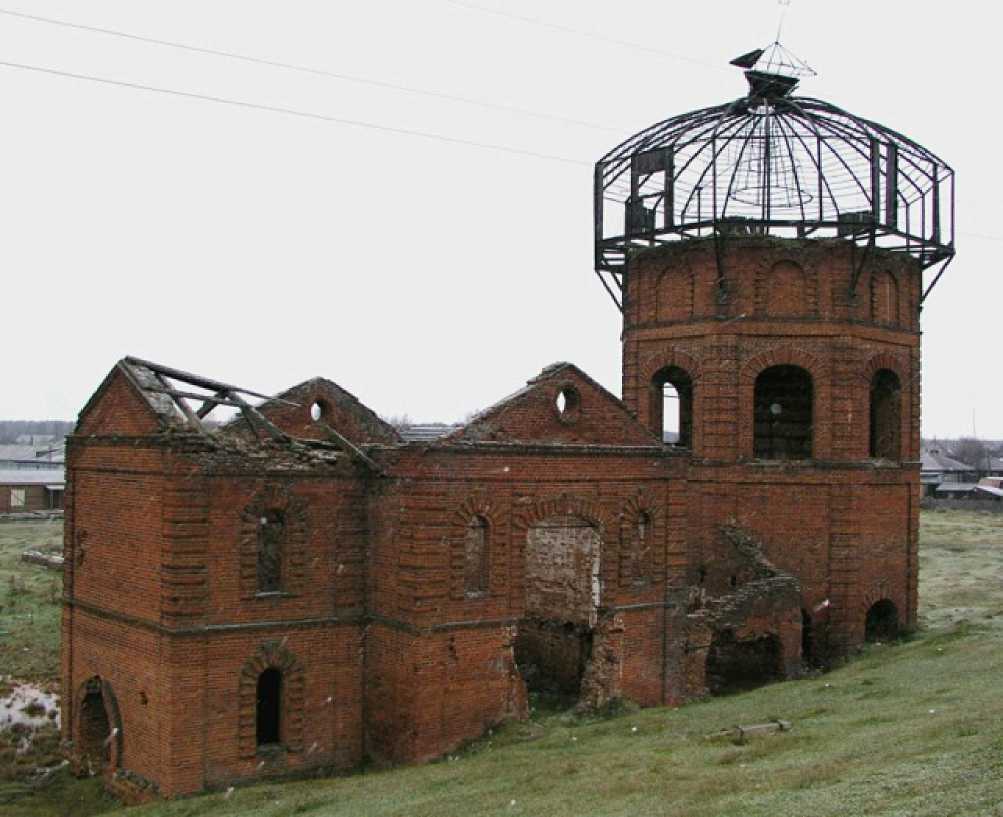
Pic. 7. Ruins of Kazhimskoye ironworks --‐ monument of ancient mining. Koigorodsky district of the Komi Republic. Photo A.A. Ievleva, 2012
The main document for information stored in the museums of geo diversity must be cata--‐ log (inventory) of the samples available database on the extent of knowledge of each sample, its geological position, origin, conservation and handling conditions (research, reference, etc.). Work Conservation geo diversity requires training in the conservation mineralogy who study and docu--‐ ment the minerals for the identification and qualification of the conservation for future genera--‐ tions.
One of the first cultural and educational institutions in the Komi region became the Na--‐ tional Museum of the Republic of Komi (Fig. 8), which opened in 1911 It is based on ethnographic and paleontological specimens collected by enthusiasts exploring our region. Today mainly fund of the museum, there are over 50 thousand items, including geological collections geologists Acade--‐ mician A. Betekhtin, Professor A.A. Chernov, discoverer Vorkuta coal deposit G.A. Chernov, etc.
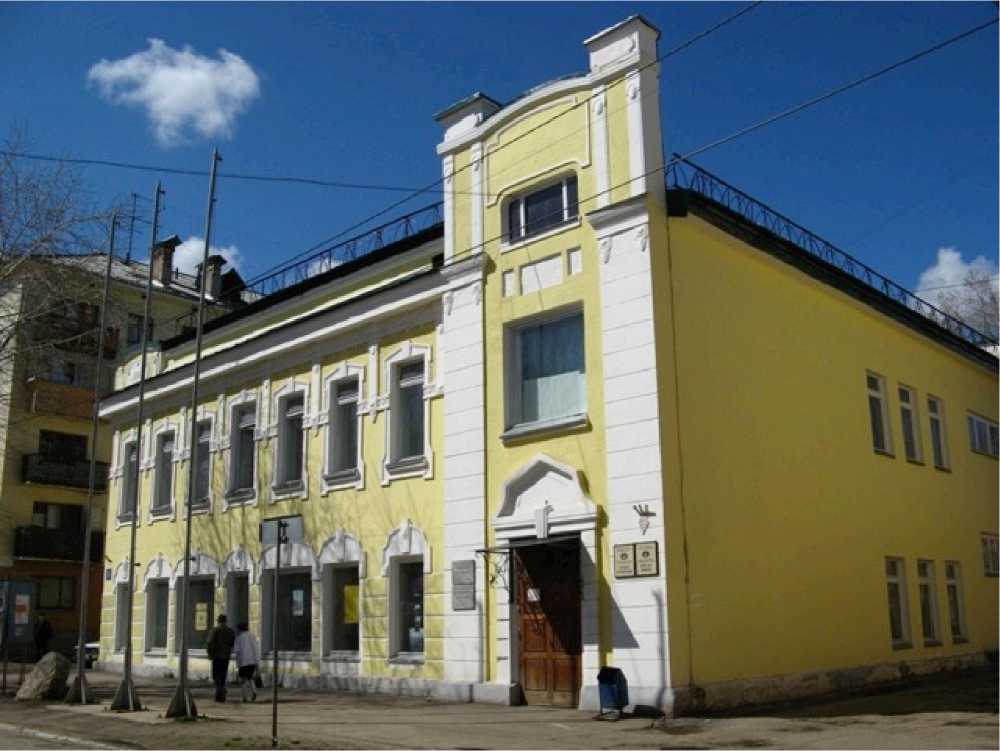
Pic. 8. The main building of the National Museum of the Republic of Komi in Syktyvkar
The first geological Museum of the Republic was established on the basis of the OGPU Ukhta expedition in 1930 founder of the museum were geologists N.T. Tihonovich, B.R. Kom--‐ panets, P.I. Antonov, N.M. Ledkov, K.G. Voynovskiy--‐Krieger, I.I. Ginzburg, G.A. Kubasov, G.A. Rash--‐ kuev, G.I. Borovko. Their collections of rocks, ores and minerals collected in the field routes, be--‐ came the basis of the museum, who wore industrial character associated with prospecting for oil. Museum ceased to exist in 1936 [5].
In 1931 appeared in Vorkuta Geological Survey, the founder of which was K. G. Voynovskiy--‐ Krieger. Under his leadership in 1945 was opened Geological Museum, which in 2000 was given the name of the scientist (Fig. 9). The main fund establishment contains over 12 thousand sam--‐ ples.
In 1941--‐1946 years, Geological Museum worked at the Central Research Laboratory in Ukhta. It was stored for more than 5 thousand exhibits, the exhibition were presented asphaltites Izhemskiy district, gypsum and oil Wow, rhinestone Urals, Vorkuta coal, grindstones Pechora, Northern Timan agates, etc. However, in the postwar period, all the exhibits and museum catalogs were lost. In 1953 he was re--‐established. In 1969 the museum was transferred Ukhtinskoe Territo--‐ rial Geological Administration, opening of the museum took place in 1971 Since 2004, the museum has become a of Ukhtinski History Museum .
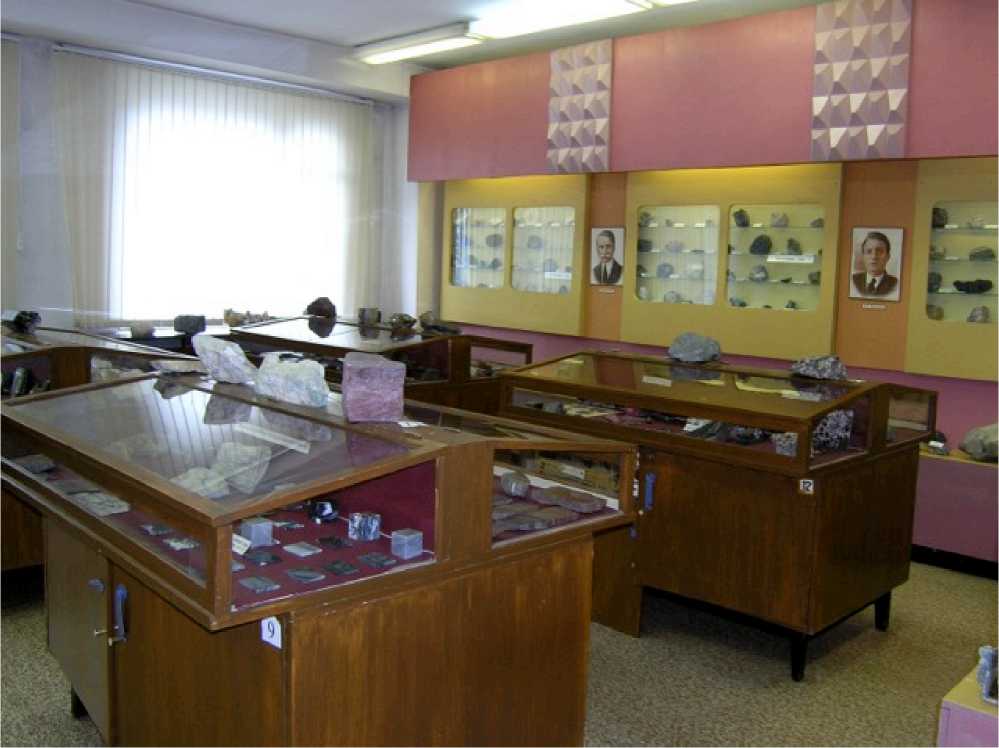
Pic. 9. Geological Museum of C.G. Vojnovsky--‐Krieger in Vorkuta
In 1959, the Geological Museum was established in Ukhta geological expedition (UGRE) (Fig. 10), worn industrial character. In 1970, the museum has been allocated space in the newly constructed building UGRE. Head of the museum became NI Matyuhin. Catalogs of the collections were opened, the walls appeared at the geological map of the Middle and Southern Timan, pho--‐ tographs of natural outcrops. Museum exhibits are located in the glass cases.
In 1967--‐1968,. began to create educational Geological Museum at Ukhta Industrial Insti--‐ tute (now Ukhta State Technical University) (Fig.11). In 1993, the museum was named A.J. Krems.
Large contribution to its development have O.S. Kochetkov, A.M. Plyakin, M.I. Fomin, A.N. Boro--‐ din, B.A. Malkov.
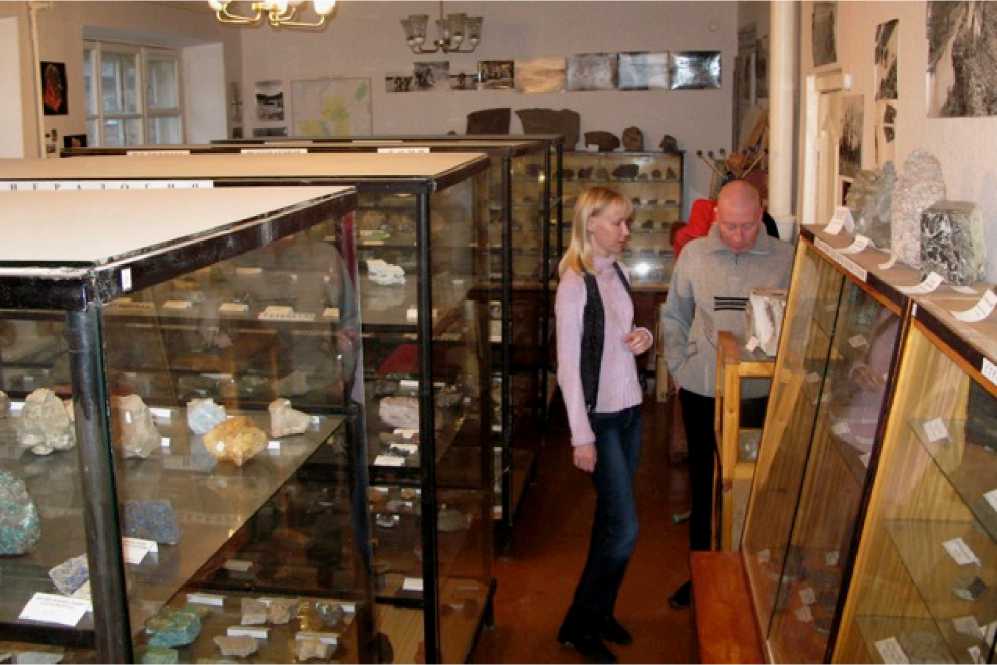
Pic. 10. Geological museum of UGRE
In 1971, when the company "Uhtaoilgasgeology" was opened the museum "Geological col--‐ lection". Initiator of its creation was the chief geologist B.J. Wasserman. The museum has more than 6100 items, including 1841 --‐ it mineralogical samples. Most of the mineralogical fund collect--‐ ed in the Komi Republic, but there are samples of minerals deposits of the Southern Urals, Trans--‐ baikalia, Kola Peninsula, Mongolia, Ukraine, Hungary, etc.
Since 1973 operates the historical museum named after A.N. Popov in the Pechora--‐Ilych Nature Reserve, which contains documents and materials of nature and ethnography of the area. In the museum there are two divisions: the nature reserve and local history. A collection of rocks and minerals.
In 1980, mining and oil Ukhtinsky college museum was created with the geological history of the college department.
Museum of the History of Education of the Komi region has emerged as the Museum of History of Syktyvkar State University in 1982 The main objective of the museum is to highlight the development of science, culture and education in the Komi region of Komi create Zyryan written before the foundation of the university. One room is devoted to the museum's halls Minerals western slope of the Urals.
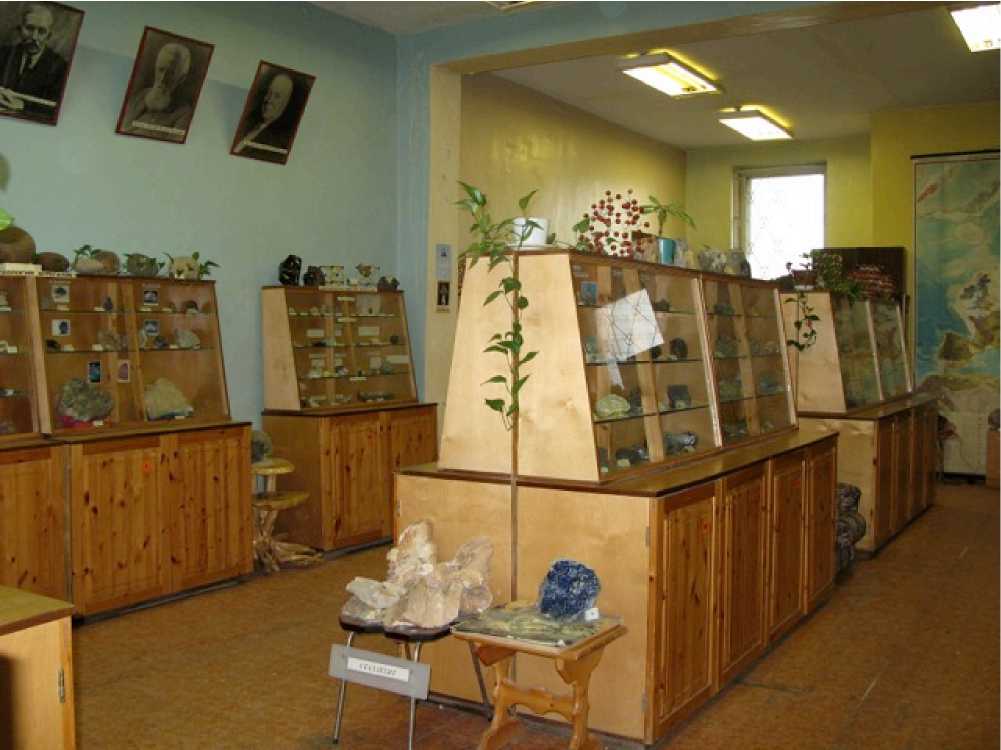
Pic. 11. Geological Museum of Ukhta State Technical University
In 1985, the Institute of Language, Literature and History, Komi Science Centre was opened Museum of Archaeology and Ethnography, whose activities are connected with the study of the archaeological sites and conducting ethnographic research in the Republic of Komi. Including re--‐ flects the history of the development of stone and metal ores for everyday life.
Geological Museum named after Professor Alexander Chernov was established as a scien--‐ tific structural unit of the Institute of Geology of Komi Science Center, located in Syktyvkar. The official date of the organization of the museum is May 21, 1968, when a decree was published Bu--‐ reau of the Department of Earth Sciences of the USSR № 9 "On the organization since 1968 Geo--‐ logical Museum of the Institute of Geology of Komi Branch of the USSR."
The first ten years the museum has existed as a scientific repository stone material collect--‐ ed Institute staff in field expeditions in the Urals, Pai--‐Khoi, Novaya Zemlya and Timan. The oppor--‐ tunity to work with him got institute scientists and specialists of other organizations. During these years, the museum staff to various Republican geological conferences, meetings and other urban activities organized temporary exhibitions and displays. The first permanent exhibition of the mu--‐ seum was opened in May 1978 (Fig. 12).
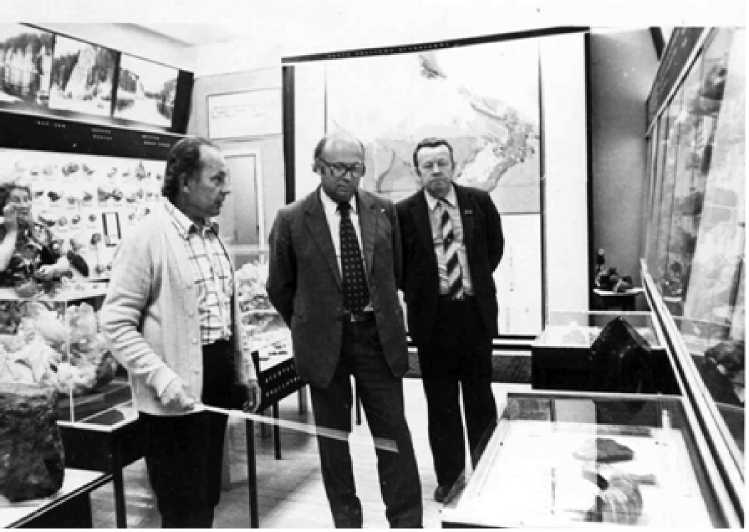
Pic. 12. N.P. Jushkin leads a tour in the first exposition hall of the museum
The museum has 591 workers and 155 monographic collections totaling 165 thousand units. There are numerous exchange fund of the geological samples. Part of the museum exposi--‐ tion area is 350 square meters. The main objectives of the museum are reflected in the museum exhibitions and collections of the stories exploration and the development of the natural re--‐ sources of the Timan--‐Northern region, as well as education and information activities to promote the pioneering achievements of Russian geologists working in the area. These problems are solved through the exhibition and storage in the museum collections and collections of rock samples, ores, minerals and paleontological objects and some other materials reflecting geo diversity of Timan--‐Northern region.
The exhibition material is placed in 8 halls of the museum: mineral resources, minerals and gems, and the evolution of life on Earth, lithology, petrology, history of geological research in the region, their hall of stone figurines "Noah's Ark" (Fig. 13). In recent years the museum annually about 250 trips, and the total number of the visitors reaches three thousand people of different ages, professions and social groups (Fig. 14).
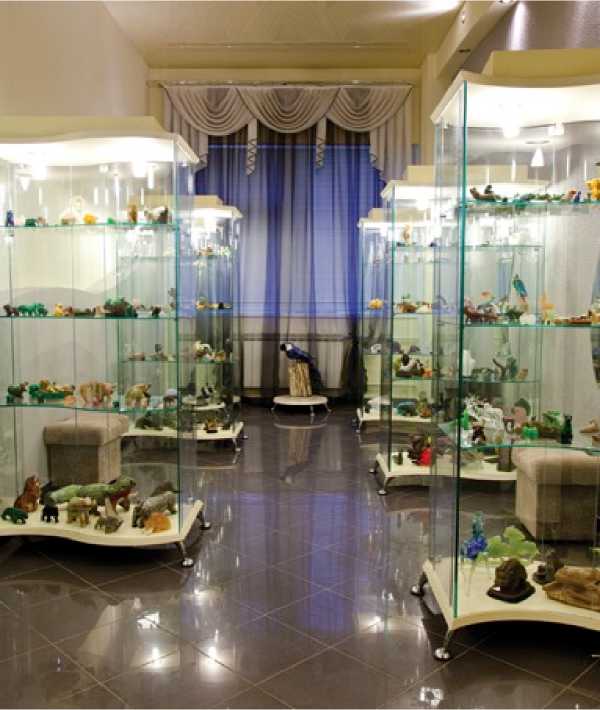
Pic. 13. Hall "Noah's Ark" of the Geological Museum named after A.A. Chernov
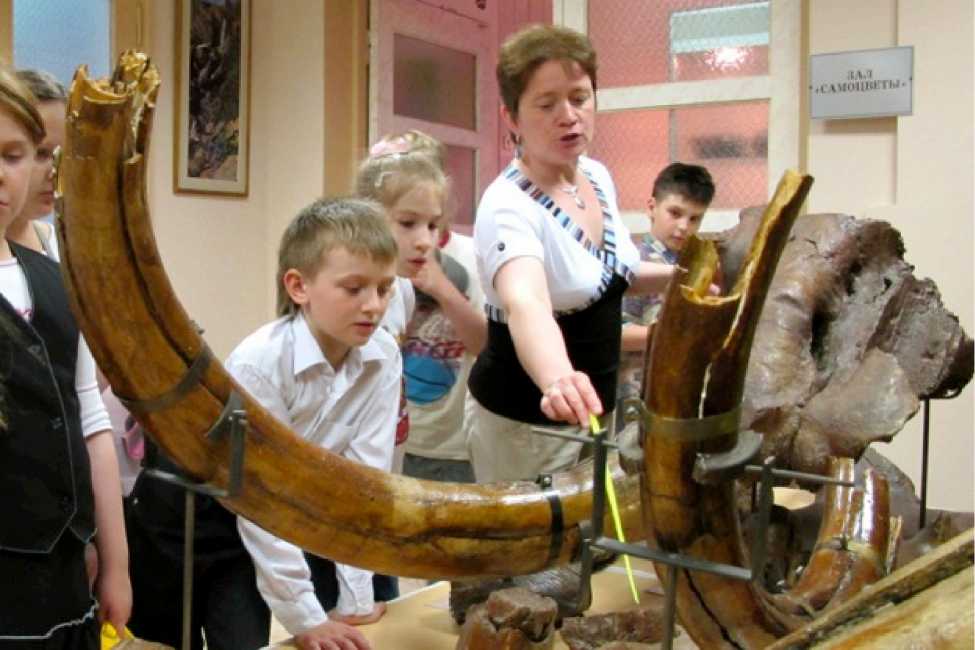
Pic. 14. S.I. Ploskova introduces the students of Syktyvkar with the bone remains of mammoths
Serve as the basis for a large public outreach activities, the museum is also a scientific base for a variety of the research work carried out by the scientists of the Institute in the cooperation with colleagues from Russia and foreign countries. In addition, they allow argued, in an attractive and visually illustrative form, conduct propaganda scientific and local knowledge in the various media of the Komi Republic and Russia. On the basis of the museum held a lecture to students of Syktyvkar State University, Komi Pedagogical Institute, Syktyvkar Forest Institute. In the halls of the Geological Museum of the AA Chernov shooting a television various Russian and foreign TV companies.
Conclusion
Geological heritage sites are an excellent basis for the scientific, cultural and aesthetic edu--‐ cation of the general population, the development of tourism, as well as the creation of a number of the business sectors related to the development of the service for travelers. In many countries around the interesting geological objects arise Geoparks where up to date information is orga--‐ nized and service users. However, the development of these areas of activity need accessible and fascinating information about the objects of the geological heritage, initiative and interest of the local authorities, business and the desire to invest in the development of tourism and related ser--‐ vices.
Unfortunately, now the objects of the geological and mineralogical heritage of the Kom Republic can only be regarded as an undoubted potential for the northern tourism.
Nevertheless, even in the absence of the tourism development programs in the northern Russia for the professionals working in the field of the study and preservation of the geo diversity, there is a wide field for work. Implementation of the basic forms of joint activities for the conser--‐ vation of geo diversity can be:
-
- exchange of the experts to become familiar with specific aspects of the conservation of the geological diversity;
-
- exchange of geological, palaeontological and mineralogical information and samples;
-
- joint field research, training seminars, visiting conferences and round tables;
-
- cooperation of the mineralogical, geological and natural history museums in order to review and transfer of good and successful experiences of exposure, information and cultural and educational activities;
-
- cooperation of mineralogical, geological and natural history museums in order to review and transfer of good and successful experiences of exposure, information and cultural and educa--‐ tional activities;
-
- preparation for printing and publication of scientific works, development of recommendations for the conservation of geological diversity as methods geoconservation and museum facili--‐ ties.
Список литературы Geological and mineralogical heritage of Komi region as a potential for the development of the North tourism
- Астахова И. С., Шевчук С. С., Филиппов В. Н. Сульфосоли висмутинайкинитового ряда на Харбейском месторождении (Полярный Урал) // Вестник Института геологии Коми научного центра УрО РАН. 2012. № 5. С. 11–14.
- Геологическое наследие Республики Коми (Россия) / Сост. П. П. Юхтанов. Сыктывкар, 2008. 350 с.
- Голдин Б. А., Юшкин Н. П., Фишман М. В. Новый иттриевый минерал — черновит // Записки ВМО. 1967. Ч. 96. Вып. 6. С. 699–704.
- Макеев А. Б., Ковальчук Н. С. Юшкинит V1-XS·∙n[(Mg,Al)(OH)2]. Сыктывкар: Геопринт, 2006. 70 с.
- Плякин А. М., Иевлев А. А. История геологических музеев Ухты (Республика Коми) // Современные тенденции в развитии музеев и музееведения. Материалы Всероссийской научно-‐практической конференции (Новосибирск, 3–5 октября 2011 г.) Новосибирск, 2011. С. 380–384.

